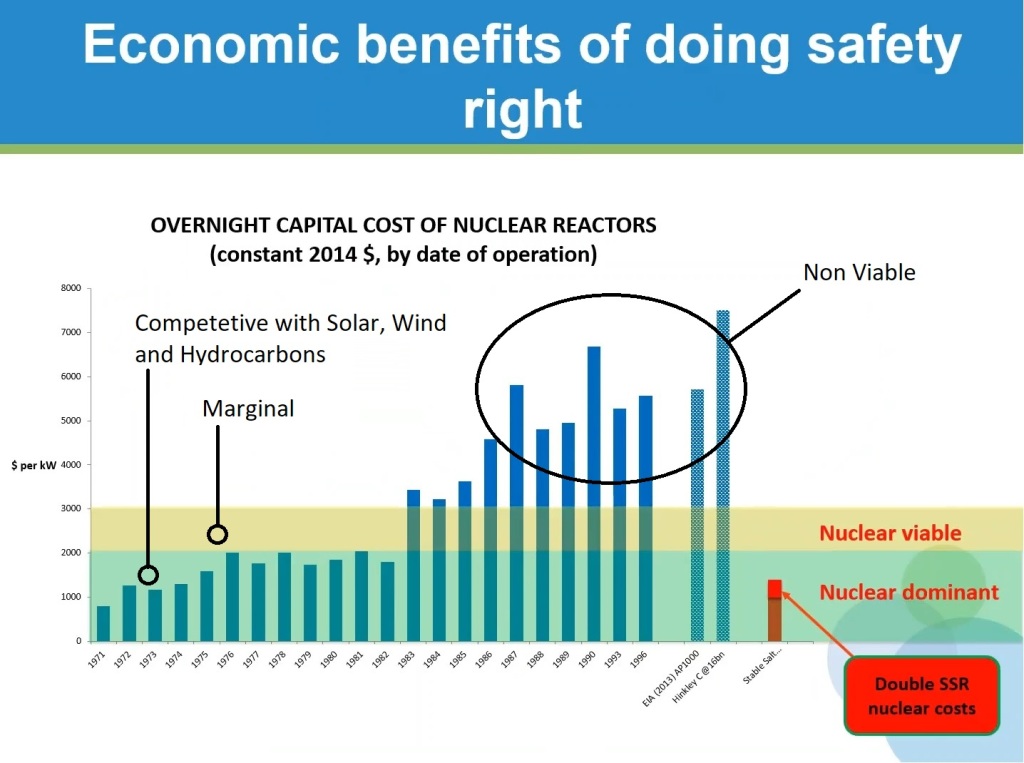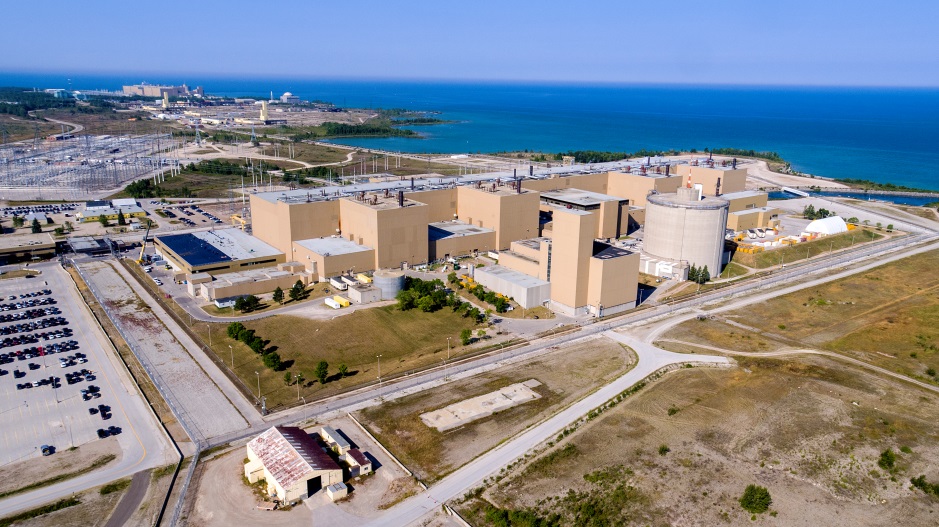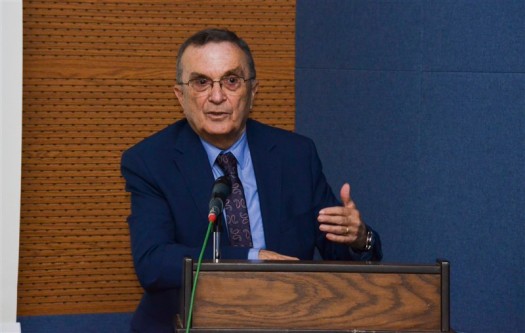
Zeichnet für den Thorium-based Molten Salt Reactor-Liquid Fuel No. 1 verantwortlich: Das Shanghai Institute of Applied Physics
Responsible for the Thorium-based Molten Salt Reactor-Liquid Fuel No. 1: The Shanghai Institute of Applied Physics
THORIUM-FLÜSSIGSALZREAKTOREN Kernreaktoren, in denen der Kernbrennstoff in Form geschmolzenen Salzes vorliegt, bieten eine Fülle von Vorteilen. In China wird in nächster Zukunft eine Versuchsanlage in Betrieb gehen
THORIUM MOLTEN SALT REACTORS Nuclear reactors in which the nuclear fuel is in the form of molten salt offer a wealth of advantages. A test plant will go into operation in China in the near future.
„Perfekte Technologie“
Der Ausgangsstoff ist billig und weltweit vorhanden, nicht einmal Kühlwasser wird benötigt und der Müll wird weniger und verfällt viel schneller als herkömmlicher Atommüll: Die Thorium-Technologie steht für eine neue Qualität der Nutzung der Kernenergie
Wolfgang Kaufmann, 23.01.2022
“Perfect technology”
The raw material is cheap and available worldwide, not even cooling water is needed and the waste is less and decays much faster than conventional nuclear waste: Thorium technology stands for a new quality of the use of nuclear energy
Wolfgang Kaufmann 23.01.2022
Im Hongshagang-Industriepark bei Wuwei in der zentralchinesischen Provinz Gansu wird in nächster Zukunft eine Versuchsanlage in Betrieb gehen, die das Potential besitzt, nicht nur die Energieerzeugung im Reich der Mitte, sondern in der ganzen Welt zu revolutionieren. Keine Kohlendioxidemissionen mehr infolge der Nutzung fossiler Brennstoffe, keine Landschaftsverschandelung durch Windräder, kein massenhafter Einsatz von Akkus aus umweltschädlicher Produktion, keine Stromausfälle bei Windstille und Bewölkung, aber auch kein Strahlungsrisiko aufgrund von Reaktorhavarien, alles das verspricht der innovative Thorium-based Molten Salt Reactor-Liquid Fuel No. 1 (TMSR-LF1) des Shanghai Institute of Applied Physics, der für eine neue Qualität der Nutzung der Kernenergie steht und dieser quasi einen „grünen Anstrich“ geben soll.
In the Hongshagang Industrial Park near Wuwei in the central Chinese province of Gansu, a pilot plant will go into operation in the near future, which has the potential to revolutionize energy production not only in the Middle Kingdom, but throughout the world. No more carbon dioxide emissions as a result of the use of fossil fuels, no more landscape degradation by wind turbines, no mass use of batteries from environmentally harmful production, no power outages in calm winds and clouds, but also no radiation risk due to reactor accidents, all this promises the innovative Thorium-based Molten Salt Reactor-Liquid Fuel No. 1 (TMSR-LF1) of the Shanghai Institute of Applied Physics, which advocates a new quality of use of the Nuclear energy is in place and this should give it a kind of “green coat of paint”.
Die Funktionsweise des Thorium-Flüssigsalzreaktors TMSR-LF1 ist relativ einfach. Das schwach radioaktive Element Thorium wird in Flüssigsalz aufgelöst und mit Neutronen beschossen. Dadurch entsteht das Isotop Uran 233, dessen Spaltung große Wärmemengen freisetzt. Der Reaktor produziert also seinen Brennstoff selbst. Dieses Verfahren bringt letztlich sehr viel mehr Sicherheit als der Betrieb klassischer Kernreaktoren (siehe unten) und darüber hinaus auch noch eine Vielzahl weiterer Vorteile.
The operation of the Thorium Molten Salt reactor TMSR-LF1 is relatively simple. The weakly radioactive element Thorium is dissolved in molten salt and bombarded with neutrons. This produces the isotope uranium 233, the fission of which releases large amounts of heat. So the reactor produces its own fuel. This process ultimately brings much more safety than the operation of classic nuclear reactors (see below) and also a variety of other advantages.
Sechs Vorteile
Six Benefits
Zum Ersten werden nur äußerst geringe Mengen an Thorium 232 benötigt. Denn der Energiegehalt einer Tonne Thorium entspricht der von 200 Tonnen Uran-Metall oder 28 Millionen Tonnen Kohle, wie der italienische Physik-Nobelpreisträger Carlo Rubbia errechnete.
First, only extremely small amounts of Thorium 232 are needed. The energy content of one ton of Thorium corresponds to that of 200 tons of uranium metal or 28 million tons of coal, as the Italian Nobel Laureate in Physics Carlo Rubbia calculated.

Zum Zweiten gibt es überall auf der Welt größere Thorium-Vorkommen. Im Prinzip kommt das Element in der Gesteinskruste ähnlich häufig vor wie Blei und fällt zudem als Abfallprodukt bei der Förderung von Seltenen Erden an. Deshalb ist es auch nicht teuer. Dahingegen drohen perspektivisch Verknappungen und Preisexplosionen beim Uran, weil die Zahl der konventionellen Kernkraftwerke neuerdings wieder deutlich zunimmt.
Secondly, there are larger Thorium deposits all over the world. In principle, the element occurs in the rock crust as often as lead and is also produced as a waste product in the extraction of rare earths. That’s why it’s not expensive. On the other hand, there is a risk of shortages and price explosions for uranium in the future, because the number of conventional nuclear power plants has recently increased significantly again.

Zum Dritten kann ein Thorium-Flüssigsalzreaktor praktisch überall errichtet werden, also beispielsweise auch in Wüstenregionen. Denn er benötigt keinerlei Kühlwasser.
Thirdly, a Thorium Molten Salt reactor can be built virtually anywhere, including desert regions, for example. Because it does not require any cooling water.

Zum Vierten entstehen bei seinem Betrieb auch deutlich weniger radioaktive Abfälle. Außerdem sollen über 99 Prozent des Atommülls aus dem TMSR-LF1 nach spätestens 300 Jahren in harmlose Isotope zerfallen sein. Des Weiteren besteht die Möglichkeit, die geringen Restmengen an länger strahlendem Material später in fortgeschritteneren Flüssigsalzreaktoren zu verarbeiten und damit gänzlich zu neutralisieren. Zum Vergleich: In mit Uran betriebenen konventionellen Atommeilern fallen langlebige radioaktive Spaltprodukte mit Halbwertszeiten von vielen tausend Jahren an, obwohl nur ein kleiner Bruchteil des verwendeten Kernbrennstoffs genutzt wird.
Fourthly, its operation also generates significantly less radioactive waste. In addition, more than 99 percent of the nuclear waste from the TMSR-LF1 is said to have decayed into harmless isotopes after 300 years at the latest. Furthermore, it is possible to process the small residual amounts of longer radiating material later in more advanced molten salt reactors and thus completely neutralise. By way of comparison, conventional nuclear reactors powered by uranium produce long-lived radioactive fission products with half-lives of many thousands of years, even though only a small fraction of the nuclear fuel used is used.

Zum Fünften liegen die Kosten für den Bau und Betrieb von Thorium-Flüssigsalzreaktoren niedriger als bei den sonst zumeist verwendeten Leichtwasser-Reaktoren. Das resultiert vor allen aus dem geringen Betriebsdruck der Anlagen, der zahlreiche Sicherheitsvorkehrungen überflüssig macht, sowie der Tatsache, dass keine Brennstäbe beschafft werden müssen.
Fifthly, the costs for the construction and operation of Thorium Molten Salt reactors are lower than those of the light-water reactors that are usually used. This is mainly due to the low operating pressure of the systems, which makes numerous safety precautions superfluous, as well as the fact that no fuel rods have to be procured.

Zum Sechsten lassen sich Reaktoren wie der TMSR-LF1 auch deshalb ausgesprochen wirtschaftlich betreiben, weil in ihnen nicht nur Uran 233 erbrütet wird, sondern zusätzlich noch viele andere radioaktive Spaltprodukte entstehen, die zum Beispiel in der Nuklearmedizin benötigt werden. Und manche der Radionuklide verwandeln sich sogar in ausgesprochen begehrte Elemente wie Rubidium, Zirconium, Molybdän, Ruthenium, Palladium, Neodym und Samarium. Desgleichen wird das Edelgas Xenon frei, das unter anderem als Isolationsmedium sowie in der Laser- und Raumfahrttechnik zum Einsatz kommt.
Sixthly, reactors such as the TMSR-LF1 can also be operated extremely economically because not only uranium 233 is incubated in them, but also many other radioactive fission products are produced, which are required, for example, in nuclear medicine. And some of the radionuclides even turn into highly sought-after elements such as rubidium, zirconium, molybdenum, ruthenium, palladium, neodymium and samarium. Likewise, the noble gas xenon is released, which is used, among other things, as an insulation medium as well as in laser and aerospace technology.
Der Krieg ist aller Dinge Vater
War is the father of all things
Erfunden wurde die dem TMSR-LF1 zugrunde liegende Technologie nicht in China, sondern in den USA. Dort experimentierten die Luftstreitkräfte bereits ab 1954 mit einem kleinen Flüssigsalzreaktor, der zum Antrieb von Langstreckenbombern dienen sollte. Das Projekt fand jedoch ein rapides Ende, als die Vereinigten Staaten über Interkontinentalraketen verfügten. Ebenso legten bundesdeutsche Wissenschaftler aus der Kernforschungsanlage Jülich zu Beginn der 1970er Jahre einige Studien über Flüssigsalzreaktoren vor, die letztlich wegen der ablehnenden Haltung des damaligen Leiters der Reaktorentwicklung, Rudolf Schulten, keine Beachtung fanden.
The technology underlying the TMSR-LF1 was not invented in China, but in the USA. As early as 1954, the Air Force experimented with a small molten salt reactor to power long-range bombers. However, the project came to a rapid end when the United States had intercontinental ballistic missiles. Likewise, at the beginning of the 1970s, West German scientists from the Jülich nuclear research facility presented some studies on molten salt reactors, which ultimately received no attention because of the negative attitude of the then head of reactor development, Rudolf Schulten [main developer of the pebble bed reactor design, a non fluid fuel system].
Ein weiterer Grund für die fehlende Akzeptanz des alternativen Reaktortyps war das absolute Desinteresse der Nu-klearindustrie rund um die Welt. Mit den klassischen Atommeilern ließ sich hervorragend Geld verdienen, und auf die Einnahmen aus der Herstellung von Brennstäben wollte auch niemand verzichten. Deshalb wurden allerlei vorgeschobene Argumente gegen den Einsatz von Flüssigsalzreaktoren ins Spiel gebracht, wie beispielsweise das angeblich höhere Korrosionsrisiko und die hypothetische Gefahr, dass jemand die Meiler missbraucht, um waffenfähiges Spaltmaterial zu produzieren.
Another reason for the lack of acceptance of the alternative reactor type was the absolute lack of interest of the nuclear industry around the world. With the classic nuclear reactors, excellent money could be earned, and no one wanted to do without the income from the production of fuel rods. Therefore, all sorts of pretended arguments against the use of molten salt reactors were brought into play, such as the allegedly higher risk of corrosion and the hypothetical danger that someone will misuse the reactors to produce weapons-grade fissile material.
Dies hat die Volksrepublik China nicht davon abgehalten, seit 2011 umgerechnet 400 Millionen Euro in die Entwicklung des TMSR-LF1 zu investieren. Schließlich verfolgt die Pekinger Führung das ehrgeizige Ziel, das Reich der Mitte bis 2050 „klimaneutral“ zu machen, und dabei könnte sich die „perfekte Technologie“ der Flüssigsalzreaktoren als absolut unverzichtbar erweisen.
This has not prevented the People’s Republic of China from investing the equivalent of 400 million euros in the development of the TMSR-LF1 since 2011. After all, Beijing’s leaders are pursuing the ambitious goal of making the Middle Kingdom “climate neutral” by 2050, and the “perfect technology” of molten salt reactors could prove absolutely indispensable.

Der Reaktor, der nun am Rande der Wüste Gobi erprobt werden soll, hat erst einmal nur eine Nennleistung von zwei Megawatt. Damit kann er lediglich um die 1000 Haushalte mit Strom versorgen. Sollte sich das Konstruktionsprinzip des TMSR-LF1 bewähren, dann würde allerdings bis etwa 2030 der erste Prototyp eines Thorium-Flüssigsalzreaktors mit 373 Megawatt Leistung in Betrieb gehen, dem dann in schneller Folge identische Anlagen in ganz China folgen. Ob Deutschland zu diesem Zeitpunkt immer noch in seiner Atomkraft-Abstinenz verharrt oder inzwischen auch auf die „Grüne Kernenergie“ setzt, bleibt abzuwarten.
The reactor, which is now to be tested on the edge of the Gobi Desert, initially has a nominal output of only two megawatts. This means that it can only supply around 1000 households with electricity. If the design principle of the TMSR-LF1 proves successful, however, the first prototype of a Thorium Molten Salt reactor with an output of 373 megawatts would go into operation by around 2030, which will then be followed by identical plants throughout China in rapid succession. It remains to be seen whether Germany will still remain in its abstinence from nuclear power at this time or whether it will now also rely on “green nuclear energy”.

Die Preußische Allgemeine Zeitung (PAZ) ist eine einzigartige Stimme in der deutschen Medienlandschaft. Woche für Woche berichtet sie über das aktuelle Zeitgeschehen in Politik, Kultur und Wirtschaft und bezieht zu den grundlegenden Entwicklungen unserer Gesellschaft Stellung. In ihrer Arbeit fühlt sich die Redaktion dem traditionellen preußischen Wertekanon verpflichtet: Das alte Preußen stand und steht für religiöse und weltanschauliche Toleranz, für Heimatliebe und Weltoffenheit, für Rechtstaatlichkeit und intellektuelle Redlichkeit sowie nicht zuletzt für ein von der Vernunft geleitetes Handeln in allen Bereichen der Gesellschaft. In diesem Sinne pflegt die PAZ eine offene Debattenkultur, die gleichermaßen den eigenen Standpunkt mit Leidenschaft vertritt wie sie die Meinung von Andersdenkenden achtet – und diese auch zu Wort kommen lässt. Jenseits des Tagesgeschehens fühlt sich die PAZ der Erinnerung an das historische Preußen und der Pflege seines kulturellen Erbes verpflichtet. Mit diesen Grundsätzen ist die Preußische Allgemeine Zeitung eine einzigartige publizistische Brücke zwischen dem Gestern, Heute und Morgen, zwischen den Ländern und Regionen in West und Ost – sowie zwischen den verschiedenen gesellschaftlichen Strömungen in unserem Lande.
The Preußische Allgemeine Zeitung (PAZ) is a unique voice in the German media landscape. Week after week, it reports on current events in politics, culture and business and takes a stand on the fundamental developments in our society. In their work, the editors feel committed to the traditional Prussian canon of values: The old Prussia stood and stands for religious and ideological tolerance, for love of homeland and open-mindedness, for the rule of law and intellectual honesty, and not least for reason-guided action in all areas of society . With this in mind, the PAZ maintains an open culture of debate, which passionately represents its own point of view and respects the opinions of those who think differently – and also lets them have their say. Beyond day-to-day events, the PAZ feels committed to remembering historical Prussia and caring for its cultural heritage. With these principles, the Preußische Allgemeine Zeitung is a unique journalistic bridge between yesterday, today and tomorrow, between the countries and regions in West and East – as well as between the different social currents in our country.
Translation courtesy of Duck Duck Go – Your personal data is nobody’s business.
Like the article? Give payments directly to PAZ here, Anerkennungszahlung
Support us to make more bilingual offerings like this via our Patreon.
References and Links
1. Original article: https://paz.de/artikel/perfekte-technologie-a6180.html
2. https://paz.de/impressum.html
3. https://english.sinap.cas.cn/
4. https://www.ans.org/news/article-3091/china-moves-closer-to-completion-of-worlds-first-thorium-reactor/
5. https://en.wikipedia.org/wiki/Thorium
6. https://de.wikipedia.org/wiki/Forschungszentrum_J%C3%BClich
7. https://en.wikipedia.org/wiki/Rudolf_Schulten
8. https://en.wikipedia.org/wiki/Pebble_bed_reactor
9. https://en.wikipedia.org/wiki/Aircraft_Reactor_Experiment
10. https://en.wikipedia.org/wiki/Aircraft_Nuclear_Propulsion
11. https://www.nextbigfuture.com/2017/12/china-spending-us3-3-billion-on-molten-salt-nuclear-reactors-for-faster-aircraft-carriers-and-in-flying-drones.html
12. https://regulatorwatch.com/reported_elsewhere/china-spending-us3-3-billion-on-molten-salt-nuclear-reactors-for-faster-aircraft-carriers-and-in-flying-drones/
13. https://www.nuclearaustralia.org.au/wp-content/uploads/2021/04/Mark_Ho_20210512.pdf
14. http://samofar.eu/wp-content/uploads/2019/07/2019-TMSR-SAMOFAR%E2%80%94%E2%80%94Yang-ZOU-PDF-version-1.pdf
15. https://threeconsulting.com/mt-content/uploads/2021/04/chinatmsr2018.pdf
https://www.gen-4.org/gif/upload/docs/application/pdf/2017-05/03_hongjie_xu_china.pdf
16. https://msrworkshop.ornl.gov/wp-content/uploads/2018/04/MSR2016-day1-15-Hongjie-Xu-Update-on-SINAP-TMSR-Research.pdf
17. https://tcw15.mit.edu/sites/default/files/documents/TMSRstatus-liuwei.pdf
18. https://paz.de/anerkennungszahlung.html
19. https://www.patreon.com/TheThoriumNetwork
20. https://help.duckduckgo.com/results/translation/
#PreußischeAllgemeineZeitung #PAZ #ShanghaiInstituteofAppliedPhysics #SINAP #ThoriumMoltenSalt #MoltenSaltFissionEnergyTechnology #MSFET #Thorium
























You must be logged in to post a comment.